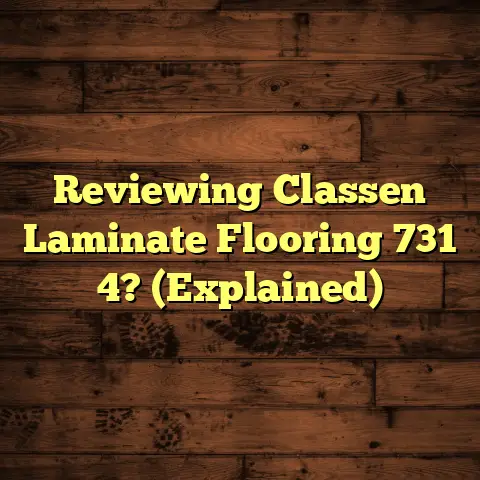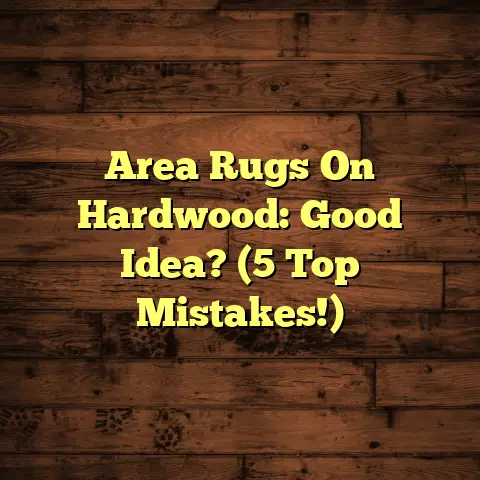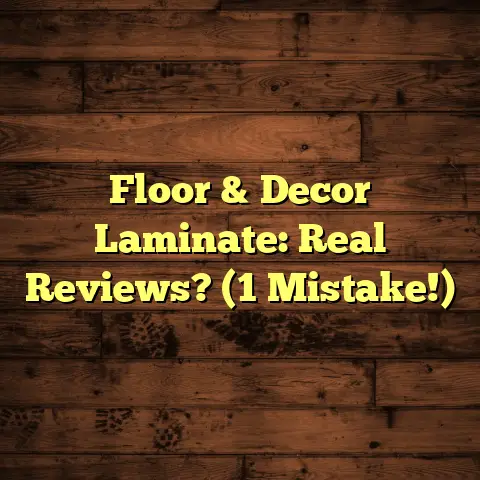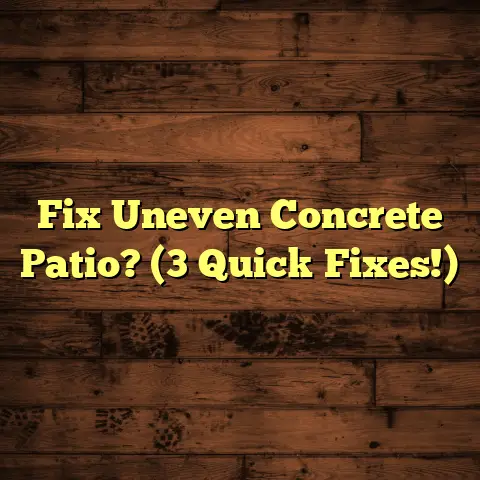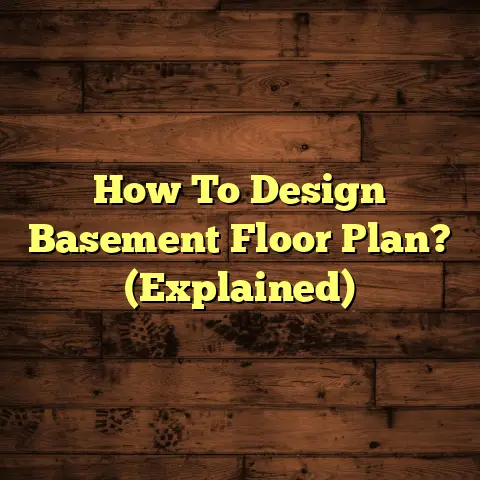Wood-Look Flooring: Best Alternatives? (2 Top Picks!)
But real hardwood? It can be a beast. Scratches, water damage, the constant need for refinishing… it’s a commitment!
That’s why I’m so excited about the amazing wood-look alternatives we have now. They give you that gorgeous aesthetic without all the headaches. I’m talking about options that can stand up to kids, pets, and even the occasional clumsy adult (we’ve all been there!).
In this article, I’m diving deep into the world of wood-look flooring. We’ll explore why it’s so popular, what makes a good alternative, and, most importantly, I’ll share my two top picks that I recommend to clients time and time again. So, let’s get started!
Section 1: Understanding Wood-Look Flooring
Definition and Characteristics
So, what exactly is wood-look flooring? Simply put, it’s any flooring material designed to mimic the appearance of natural hardwood.
We’re talking about materials like:
-
Laminate: This is a multi-layer synthetic flooring product fused together with a lamination process. It’s got a photographic applique layer underneath a clear protective layer.
-
Luxury Vinyl Plank (LVP): LVP is a type of vinyl flooring that comes in long, narrow strips, just like wood planks. It’s typically made of multiple layers, including a waterproof core and a realistic-looking decorative layer.
-
Porcelain Tile: These are made from a dense clay and fired at high temperatures, making them incredibly durable and water-resistant.
But it’s not just about the material. It’s about the details. Manufacturers have gotten incredibly good at replicating the texture, finish, and visual variations you’d find in real wood.
Think about it: embossed textures that feel like real wood grain, hand-scraped finishes, and even variations in color and knot patterns. You can find wood-look flooring that mimics everything from rustic oak to sleek, modern maple. In many cases, it’s tough to tell the difference from the real deal!
Durability and Maintenance
Okay, let’s get down to brass tacks. How does wood-look flooring stack up against real hardwood in terms of durability and maintenance? This is where the alternatives really shine.
| Feature | Hardwood | Wood-Look Alternatives (General) |
|---|---|---|
| Scratch Resistance | Moderate; prone to scratches from pets & traffic | Generally High; more scratch-resistant |
| Water Resistance | Low; susceptible to water damage & warping | High; often waterproof or water-resistant |
| Fade Resistance | Moderate; can fade with prolonged sun exposure | High; UV resistant |
| Maintenance | Requires regular refinishing & special cleaners | Easy; often just sweeping & mopping |
As you can see, wood-look alternatives generally offer superior durability. They’re more resistant to scratches, moisture, and fading. This makes them ideal for high-traffic areas, homes with pets and kids, and even bathrooms and kitchens where real hardwood would be a risky choice.
Maintenance is also a breeze. Forget about specialized cleaners and expensive refinishing. Most wood-look options can be cleaned with a simple damp mop and a mild detergent.
Cost-Effectiveness
Let’s talk money. Real hardwood is beautiful, but it can also be a major investment. Not only is the material itself expensive, but installation costs can also add up quickly.
Wood-look alternatives, on the other hand, are generally more affordable. Here’s a quick comparison:
- Hardwood: \$5 – \$15+ per square foot (material only)
- Laminate: \$1 – \$5 per square foot (material only)
- LVP: \$2 – \$7 per square foot (material only)
- Porcelain Tile: \$3 – \$10 per square foot (material only)
Note: These are just estimates, and prices can vary depending on the specific product, location, and installer.
But the cost savings don’t stop there. Remember those maintenance costs we talked about? With wood-look flooring, you’ll save money on specialized cleaners and you’ll avoid the need for costly refinishing down the road.
Section 2: Top Picks for Wood-Look Flooring Alternatives
Alright, here’s what you’ve been waiting for! After years of installing and working with different types of flooring, these are my two top picks for wood-look alternatives:
Top Pick #1: Luxury Vinyl Plank (LVP) Flooring
Overview and Benefits
Luxury Vinyl Plank (LVP) has become a powerhouse in the flooring industry, and for good reason. It’s a multi-layered synthetic flooring that’s specifically designed to mimic the look and feel of real wood.
But it’s not just about aesthetics. LVP offers a ton of practical benefits, including:
-
Waterproof Nature: This is a huge selling point. LVP is completely waterproof, making it ideal for kitchens, bathrooms, basements, and any other area prone to moisture.
-
Comfort Underfoot: LVP is generally softer and warmer underfoot than tile or hardwood. This makes it a more comfortable option for standing and walking, especially for long periods.
-
Sound Insulation: LVP can help to dampen sound, making it a great choice for apartments, condos, and homes with multiple stories.
Durability Features
When it comes to durability, LVP is a workhorse. It can withstand:
-
High Traffic: LVP is designed to hold up to heavy foot traffic, making it a great choice for busy households and commercial spaces.
-
Spills: Because it’s waterproof, LVP can handle spills without warping, staining, or other damage.
-
Pet Activity: LVP is scratch-resistant, so it can stand up to the claws of your furry friends.
Most LVP products come with warranties that range from 10 years to a lifetime, depending on the quality and thickness of the wear layer. When properly installed and maintained, LVP can easily last for 20 years or more.
Design Options
One of the things I love most about LVP is the sheer variety of design options available. You can find LVP that mimics just about any wood species, from classic oak and maple to exotic hardwoods like Brazilian cherry and acacia.
Advancements in printing technology have made LVP increasingly realistic. High-resolution images and embossed textures create a look and feel that’s virtually indistinguishable from real wood.
Installation Process
LVP is relatively easy to install, especially if you choose a click-lock system. This type of LVP simply snaps together, making it a great option for DIYers.
However, proper subfloor preparation is essential. The subfloor must be clean, level, and dry before you start installing LVP.
Acclimation is also important. You should allow the LVP to sit in the room where it will be installed for at least 48 hours before you begin. This will allow the material to adjust to the temperature and humidity of the room, which can help prevent warping or buckling later on.
Real-Life Applications
I’ve installed LVP in countless homes over the years, and I’ve consistently been impressed with the results.
For example, I recently worked with a family who had three young children and two dogs. They were tired of their scratched-up hardwood floors and wanted a more durable, low-maintenance option. We installed LVP throughout their main living areas, and they absolutely love it. They say it looks great, it’s easy to clean, and they no longer have to worry about their kids and pets damaging the floors.
Top Pick #2: Porcelain Tile with Wood-Look Finish
Overview and Benefits
Porcelain tile is another fantastic alternative to real wood, especially if you’re looking for maximum durability and water resistance.
Porcelain is made from a dense clay and fired at extremely high temperatures, making it incredibly strong and resistant to moisture, stains, and heavy impacts.
Here are some of the key benefits of wood-look porcelain tile:
-
Resistance to Moisture: Porcelain is virtually impervious to water, making it an ideal choice for bathrooms, kitchens, and other areas prone to moisture.
-
Resistance to Stains: Porcelain is non-porous, so it’s highly resistant to stains from food, drinks, and other spills.
-
Resistance to Heavy Impacts: Porcelain is incredibly strong and can withstand heavy impacts without cracking or chipping.
Durability Features
When it comes to longevity and wear resistance, porcelain tile is in a league of its own. It’s one of the most durable flooring options available, and it can easily last for 50 years or more with proper care.
Porcelain is also a great choice for high-moisture areas like bathrooms and kitchens. Unlike real wood, porcelain won’t warp, rot, or develop mold when exposed to water.
Design Options
Wood-look porcelain tile is available in a wide range of designs, finishes, colors, and sizes. You can find tiles that mimic just about any wood species, from rustic pine to elegant walnut.
Technological advancements have made wood-look porcelain tiles increasingly realistic. High-definition printing and textured surfaces create a look and feel that’s remarkably similar to real wood.
Installation Process
Porcelain tile installation is a bit more involved than LVP installation. It requires a skilled installer and proper grout techniques.
The subfloor must be perfectly level and stable before you start installing porcelain tile. You’ll also need to use a high-quality thin-set mortar to adhere the tiles to the subfloor.
Grouting is another critical step. The grout lines must be properly sealed to prevent water from seeping underneath the tiles.
Real-Life Applications
I recently worked with a restaurant owner who wanted to create a warm, inviting atmosphere in his dining room. He loved the look of hardwood floors, but he was concerned about the wear and tear from heavy foot traffic and spills. We installed wood-look porcelain tile throughout the dining room, and he’s been thrilled with the results. He says the tile looks great, it’s easy to clean, and it’s holding up beautifully to the demands of a busy restaurant.
Conclusion
So, there you have it! My top two picks for wood-look flooring alternatives: Luxury Vinyl Plank (LVP) and Porcelain Tile.
Both of these options offer the beauty of wood without the associated drawbacks. They’re durable, water-resistant, easy to maintain, and more affordable than real hardwood.
When choosing the best flooring option for your space, consider your specific needs and preferences. If you’re looking for a waterproof, comfortable, and DIY-friendly option, LVP is a great choice. If you need maximum durability and water resistance, porcelain tile is the way to go.
No matter which option you choose, you can rest assured that you’re getting a beautiful and practical flooring solution that will stand the test of time. Happy flooring!
